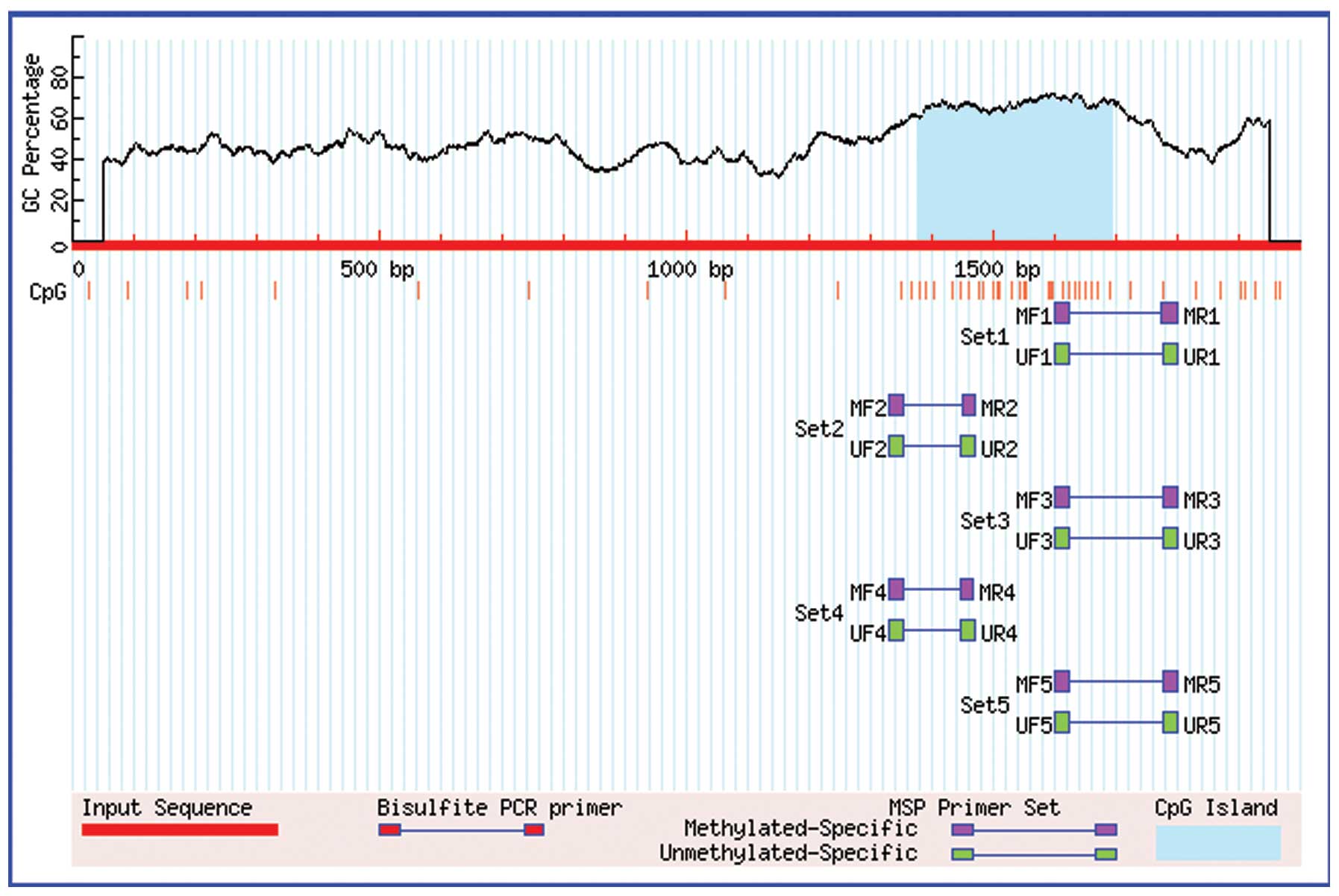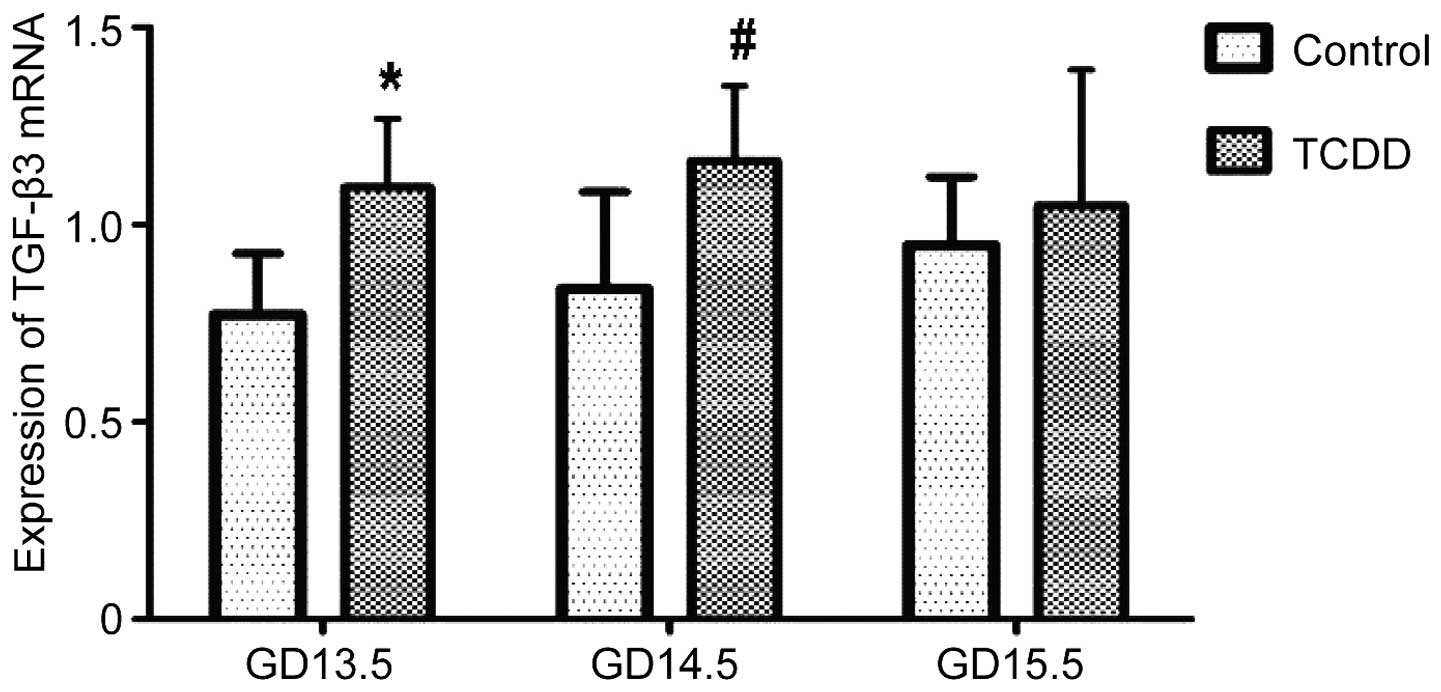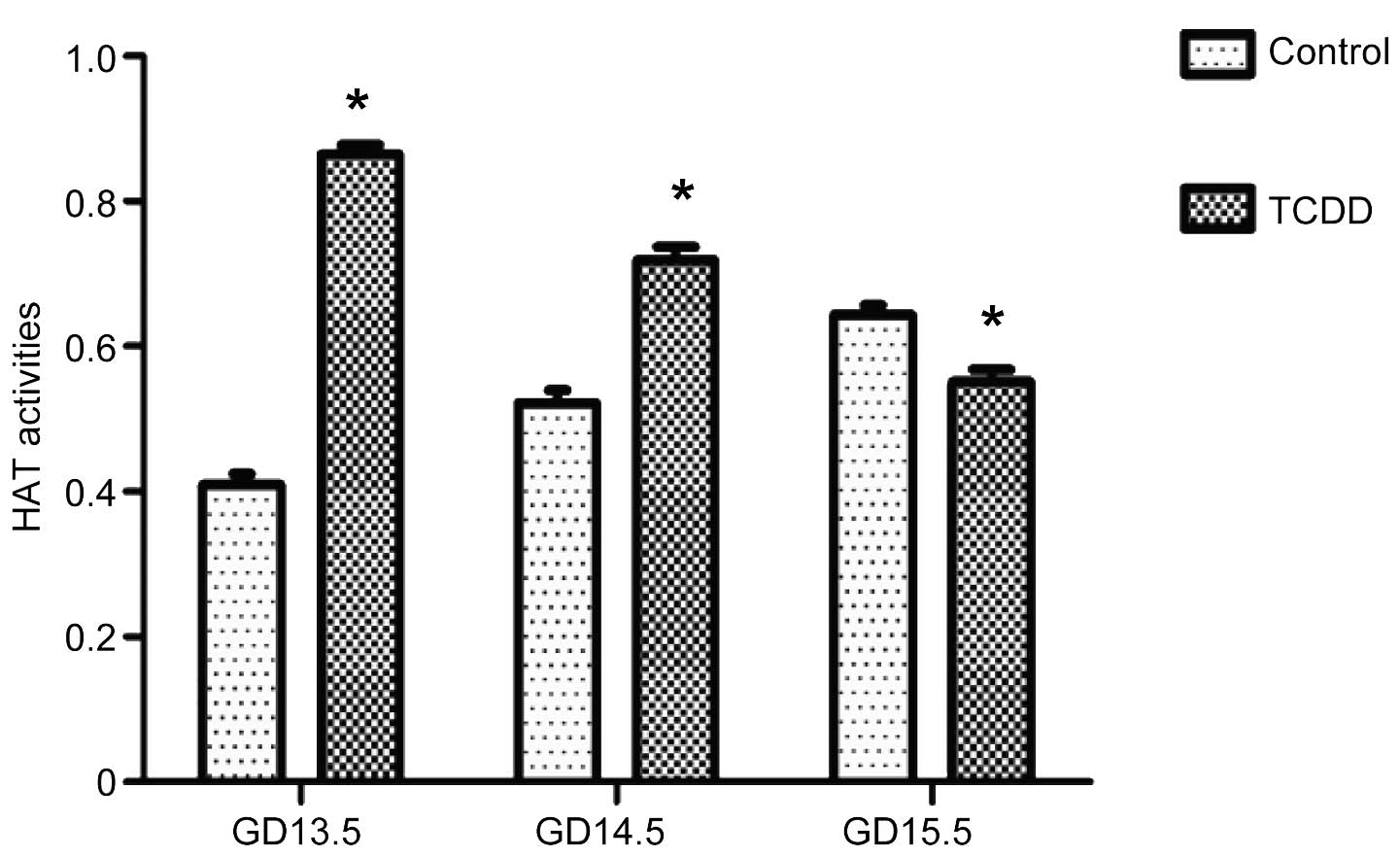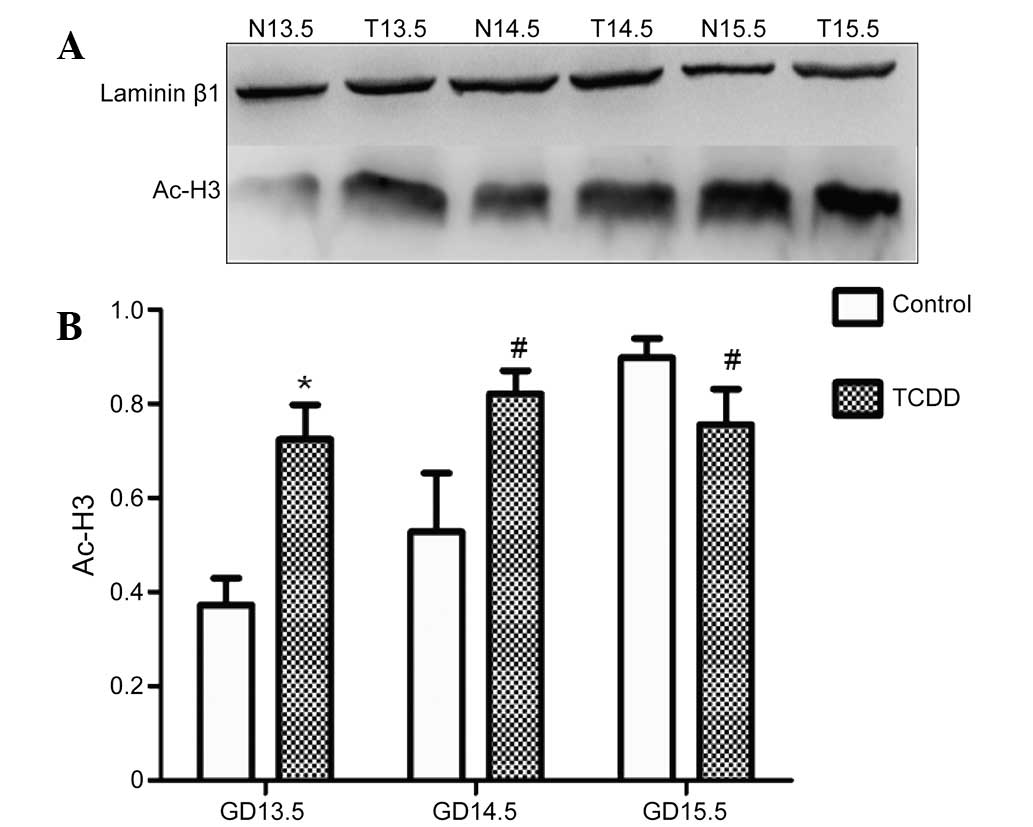|
1
|
Wehby GL and Cassell CH: The impact of
orofacial clefts on quality of life and healthcare use and costs.
Oral Dis. 16:3–10. 2010. View Article : Google Scholar
|
|
2
|
Leite IC, Paumgartten FJ and Koifman S:
Chemical exposure during pregnancy and oral clefts in newborns. Cad
Saude Publica. 18:17–31. 2002. View Article : Google Scholar : PubMed/NCBI
|
|
3
|
Murray JC: Gene/environment causes of
cleft lip and/or palate. Clin Genet. 61:248–256. 2002. View Article : Google Scholar : PubMed/NCBI
|
|
4
|
Yamada T, Hirata A, Sasabe E, Yoshimura T,
Ohno S, Kitamura N and Yamamoto T: TCDD disrupts posterior
palato-genesis and causes cleft palate. J Craniomaxillofac Surg.
42:1–6. 2014. View Article : Google Scholar
|
|
5
|
Proetzel G, Pawlowski SA, Wiles MV, Yin M,
Boivin GP, Howles PN, Ding J, Ferguson MW and Doetschman T:
Transforming growth factor-beta 3 is required for secondary palate
fusion. Nat Genet. 11:409–414. 1995. View Article : Google Scholar : PubMed/NCBI
|
|
6
|
Marazita ML, Lidral AC, Murray JC, Field
LL, Maher BS, Goldstein McHenry T, Cooper ME, Govil M, Daack-Hirsch
S, Riley B, et al: Genome scan, fine-mapping and candidate gene
analysis of non-syndromic cleft lip with or without cleft palate
reveals phenotype-specific differences in linkage and association
results. Hum Hered. 68:151–170. 2009. View Article : Google Scholar :
|
|
7
|
Jenuwein T: The epigenetic magic of
histone lysine methylation. FEBS J. 273:3121–3135. 2006. View Article : Google Scholar : PubMed/NCBI
|
|
8
|
Gan LQ, Fu YX, Liu X, Qiu L, Wu SD, Tian
XF, Liu Y and Wei GH: Transforming growth factor-beta3 expression
up-regulates on cleft palates induced by
2,3,7,8-tetrachloro-dibenzo-p-dioxin in mice. Toxicol Ind Health.
25:473–478. 2009. View Article : Google Scholar : PubMed/NCBI
|
|
9
|
Kuriyama M, Udagawa A, Yoshimoto S,
Ichinose M, Sato K, Yamazaki K, Matsuno Y, Shiota K and Mori C: DNA
meth-ylation changes during cleft palate formation induced by
retinoic acid in mice. Cleft Palate Craniofac J. 45:545–551. 2008.
View Article : Google Scholar : PubMed/NCBI
|
|
10
|
McClure EA, North CM, Kaminski NE and
Goodman JI: Changes in DNA methylation and gene expression during
2,3,7,8-tetrachlorodibenzo-p-dioxin-induced suppression of the
lipopolysaccharide-stimulated IgM response in splenocytes. Toxicol
Sci. 120:339–348. 2011. View Article : Google Scholar : PubMed/NCBI
|
|
11
|
Kouzarides T: Chromatin modifications and
their function. Cell. 128:693–705. 2007. View Article : Google Scholar : PubMed/NCBI
|
|
12
|
Cuiping L, Xingang Y, Yuexian F, Lin Q,
Xiaofei T, Yan L and Guanghui W: The role of histone H3 acetylation
on cleft palate in mice induced by
2,3,7,8-tetrachlorodibenzopdioxin. Zhonghua Zheng Xing Wai Ke Za
Zhi. 30:369–372. 2014.In Chinese. PubMed/NCBI
|
|
13
|
National Research Council: Guide for the
Care and Use of Laboratory Animals. 8th edition. National Academy
Press; Washington, DC: 2011
|
|
14
|
Livak KJ and Schmittgen TD: Analysis of
relative gene expression data using real-time quantitative PCR and
the 2(-Delta Delta C(T)) method. Methods. 25:402–408. 2001.
View Article : Google Scholar
|
|
15
|
Li LC and Dahiya R: MethPrimer: Designing
primers for methylation PCRs. Bioinformatics. 18:1427–1431. 2002.
View Article : Google Scholar : PubMed/NCBI
|
|
16
|
Beaty TH, Maestri NE, Hetmanski JB,
Wyszynski DF, Vanderkolk CA, Simpson JC, McIntosh I, Smith EA,
Zeiger JS, Raymond GV, et al: Testing for interaction between
maternal smoking and TGFA genotype among oral cleft cases born in
Maryland 1992–1996. Cleft Palate Craniofac J. 34:447–454. 1997.
View Article : Google Scholar : PubMed/NCBI
|
|
17
|
Hwang SJ, Beaty TH, Panny SR, Street NA,
Joseph JM, Gordon S, McIntosh I and Francomano CA: Association
study of transforming growth factor alpha (TGF alpha) TaqI
polymorphism and oral clefts: Indication of gene-environment
interaction in a population-based sample of infants with birth
defects. Am J Epidemiol. 141:629–636. 1995.PubMed/NCBI
|
|
18
|
Shaw GM, Wasserman CR, Lammer EJ, O'Malley
CD, Murray JC, Basart AM and Tolarova MM: Orofacial clefts,
parental cigarette smoking, and transforming growth factor-alpha
gene variants. Am J Hum Genet. 58:551–561. 1996.PubMed/NCBI
|
|
19
|
Seelan RS, Mukhopadhyay P, Pisano MM and
Greene RM: Developmental epigenetics of the murine secondary
palate. ILAR J. 53:240–252. 2012. View Article : Google Scholar
|
|
20
|
Thomae TL, Stevens EA and Bradfield CA:
Transforming growth factor-beta3 restores fusion in palatal shelves
exposed to 2,3,7,8-tetrachlorodibenzo-p-dioxin. J Biol Chem.
280:12742–12746. 2005. View Article : Google Scholar : PubMed/NCBI
|
|
21
|
He X, Liu C, Pu Y, Gan L, Yuan X, Wei G
and Fu Y: Be based on the morphological and histological changes to
study optimal dose of TCDD induced cleft palate in mice embryo. Wei
Sheng Yan Jiu. 42:277–281. 2013.In Chinese. PubMed/NCBI
|
|
22
|
Deaton AM, Webb S, Kerr AR, Illingworth
RS, Guy J, Andrews R and Bird A: Cell type-specific DNA methylation
at intragenic CpG islands in the immune system. Genome Res.
21:1074–1086. 2011. View Article : Google Scholar : PubMed/NCBI
|
|
23
|
Lind L, Penell J, Luttropp K, Nordfors L,
Syvänen AC, Axelsson T, Salihovic S, van Bavel B, Fall T, Ingelsson
E and Lind PM: Global DNA hypermethylation is associated with high
serum levels of persistent organic pollutants in an elderly
population. Environ Int. 59:456–461. 2013. View Article : Google Scholar : PubMed/NCBI
|
|
24
|
Papoutsis AJ, Borg JL, Selmin OI and
Romagnolo DF: BRCA-1 promoter hypermethylation and silencing
induced by the aromatic hydrocarbon receptor-ligand TCDD are
prevented by resveratrol in MCF-7 cells. J Nutr Biochem.
23:1324–1332. 2012. View Article : Google Scholar
|
|
25
|
Manikkam M, Tracey R, Guerrero-Bosagna C
and Skinner MK: Dioxin (TCDD) induces epigenetic transgenerational
inheritance of adult onset disease and sperm epimutations. PLoS
One. 7:e462492012. View Article : Google Scholar : PubMed/NCBI
|
|
26
|
Ornoy A: Valproic acid in pregnancy: How
much are we endangering the embryo and fetus? Reprod Toxicol.
28:1–10. 2009. View Article : Google Scholar : PubMed/NCBI
|
|
27
|
Phiel CJ, Zhang F, Huang EY, Guenther MG,
Lazar MA and Klein PS: Histone deacetylase is a direct target of
valproic acid, a potent anticonvulsant, mood stabilizer and
teratogen. J Biol Chem. 276:36734–36741. 2001. View Article : Google Scholar : PubMed/NCBI
|
|
28
|
Takeda T, Fujii M, Taura J, Ishii Y and
Yamada H: Dioxin silences gonadotropin expression in perinatal pups
by inducing histone deacetylases: A new insight into the mechanism
for the imprinting of sexual immaturity by dioxin. J Biol Chem.
287:18440–18450. 2012. View Article : Google Scholar : PubMed/NCBI
|
|
29
|
Ingelman-Sundberg M, Zhong XB, Hankinson
O, Beedanagari S, Yu AM, Peng L and Osawa Y: Potential role of
epigenetic mechanisms in the regulation of drug metabolism and
transport. Drug Metab Dispos. 41:1725–1731. 2013. View Article : Google Scholar : PubMed/NCBI
|




















